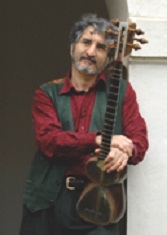
GERARD DER HAROUTIOUNIAN
Singer, tar player and musicologist. Der Haroutiounian graduated from the Komitas State Conservatory in Yerevan (tar) and the Sorbonne University in Paris. He received his Master’s Degree in Musicology with the thesis entitled “Tonality and Modality in Armenian Music”. Der Haroutiounian teaches at the Paris Academy. He is a winner of international contests and an author of a number of articles.
KOMITAS VARDAPET’S UNRECOGNIZED CREATIVE MODERNITY ACCORDING TO HIS DIVINE LITURGY
At the origins of the modernization of the 20th century, the Armenian Apostolic Church, under Western influence, raises the issue of the modernization of the liturgy through polyphony. It is interesting to understand the aesthetic goals of the creation of Armenian sacred music and the musical obstacles that the compo-sers had previously faced. The harmonization of the polyphony of the Divine Liturgy has been of interest to different rebellious musicians, such as Kara-Mourza, Yekmalyan and Komitas. In 1908 Komitas proposed an innovative and truly modernized harmonization of the Divine Liturgy for the coronation of the new Catholicos. It was officially rejected by the church and was only published in Paris in 1933 with the efforts of his students and the support of Luis Laloy. Meanwhile, the secular version of Makar Yekmelyan, published in 1896, is being used during Sunday Service up till today and has received official permission for being printed. Which were the reasons that the church did not approve of Komitas’s polyphonic liturgy, which, by the way, is of undeniable interest for musicology?
We are reflecting upon the musical activity of Komitas. We are particularly observing the influence of the Western music and tonality on the musical thought. Nevertheless, despite mastering the harmonization of tonality, and as opposing to Yekmalyan, Komitas was proposing modal polyphony in his liturgy. With the help of the comparative analysis of the fragments from the liturgies by the aforementioned composers we present the modal polyphonic concept proposed by Komitas, which modernizes the tradition. Therefore we state, that, for the sake of regaining a new spirit, the Armenian Apostolic Church, indeed, had to have an open outlook of the world, thus, prioritising the ideological and political goals and rejecting Komitas’s modernist musical choice.